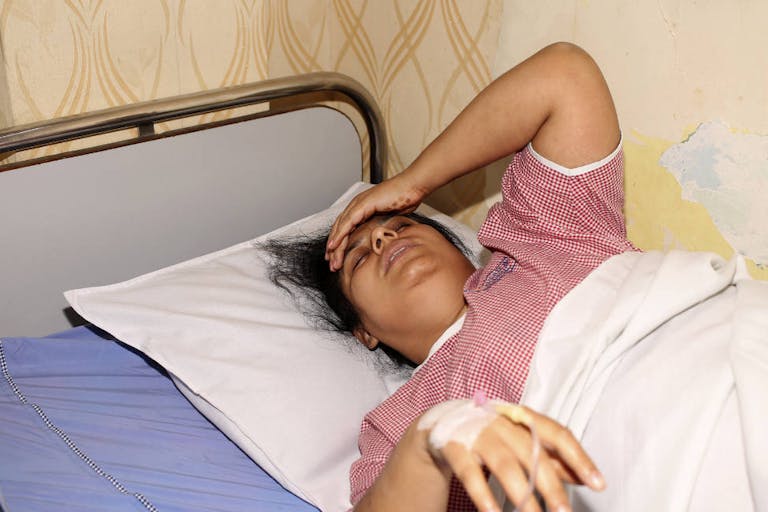
Sharon Osbourne says her kids and grandkids are 'the reason' she's still alive
Cassy Cooke
·
Millions suffered forced sterilization in India and Japan due to eugenic ideology
In Asia, forced sterilization — a serious breach of human dignity practiced in many countries under the pretexts of public health, social engineering, and population control — has reared its ugly head in diverse forms in countries like India and Japan.
Forced sterilization involves the long-term and irreversible removal of a woman’s ability to reproduce without her informed, free, and full consent. Impoverished women, women with disabilities, and those stigmatized by their communities are among those usually targeted. Forced sterilization usually happens within a disturbing eugenic framework meant to control the growth of populations regarded as undesirable.
Forced sterilization has left a terrible mark in Asian countries such as India and Japan, often targeting vulnerable populations for eugenic reasons.
Even in very recent years, India has involuntary sterilized people to control the population. Despite the loss of life and damage to women over the years, the country continues to employ coercive policies.
In Japan, around 25,000 people were forcibly sterilized over the course of 50 years. Some victims were even pre-pubescent children. Though the country’s eugenics laws ended in the 90s, many still live with lifelong effects.
While population control policies motivated India’s forced sterilization campaigns, especially during the 1970s and beyond, it was eugenic ideologies aimed at “unfit” people (including those with disabilities) which largely impacted Japan’s sterilization programs.
During the 1970s Emergency Period under then-Prime Minister Indira Gandhi, India’s forced sterilization programs led to the coerced sterilization of more than six million men and women. Moreover, pressured by pro-abortion global institutions such as the World Bank, the Indian government enforced mass sterilization campaigns meant to decrease birth rates in the country.
Consequently, many victims of these forced sterilization campaigns, such as economically impoverished men who had to undergo mandatory vasectomies, perished due to failed surgeries and terrible health conditions.
Citing science journalist Mara Hvistendahl, the BBC had this to say about 1970s India:
An astonishing 6.2 million Indian men were sterilised in just a year, which was ‘15 times the number of people sterilised by the Nazis’. India has a dark history of state-sponsored population control, often with eugenic aims – targeting the poor and underprivileged.
The BBC article added:
Since family planning efforts began in the 1970s, India has focused its population control efforts on women, even though, as scientists say, sterilisations are easier to perform in men. ‘This may be because women are deemed less likely to protest,” says Ms Hvistendahl.
Alarmingly, sterilization campaigns in India still persisted even into the 21st century, mainly targeting impoverished rural women with insufficient informed consent. “More than 700 deaths were reported due to botched surgeries between 2009 and 2012,” the BBC reported.
In India, sterilization procedures are frequently performed under unethical, unsafe and unhygienic conditions. In 2014, 15 women lost their lives in sterilization camps in India’s Chhattisgarh due to mediocre medical standards.
Additionally, the Indian government’s (and their various pro-abortion international backers’) singling out of rural and impoverished communities for sterilization has further entrenched contemporary mistrust among various groups in Indian society. Many sterilized men and women or those targeted for sterilization are either disabled and/or hail from Scheduled Castes or lower socioeconomic groups.
Mass sterilization campaigns supported by successive Indian administrations have left a grim mark on India’s history, serving as unhappy reminders of abuses of state power at the expense of vulnerable citizens. Yet the reprehensible practice still lingers on to this very day.
A March 2023 article published on the website of the London School of Economics (LSE) lambasted contemporary sterilization practices in India:
With a growing population of more than 1 billion people, even today successive Indian governments have been accused of performing involuntary sterilization camps in unsanitary and unsafe conditions that often target the poor and vulnerable sections of society as a method of population control.
Governments at the state and district level are allocated funds for family planning, which often assigns certain numbers or targets for sterilizing the population as a mode of permanent contraception.
In 2020, the state of Madhya Pradesh issued a circular to multi-purpose health workers (MPHWs) to persuade at least 5 willing male beneficiaries for sterilization, and any failure to complete the given task would result in consequences ranging from their salaries being withheld to a compulsory retirement.
Article continues below
Dear Reader,
In 2026, Live Action is heading straight where the battle is fiercest: college campuses.
We have a bold initiative to establish 100 Live Action campus chapters within the next year, and your partnership will make it a success!
Your support today will help train and equip young leaders, bring Live Action’s educational content into academic environments, host on-campus events and debates, and empower students to challenge the pro-abortion status quo with truth and compassion.
Invest in pro-life grassroots outreach and cultural formation with your DOUBLED year-end gift!
While the government repealed the order after strong backlash from citizens and opposition political parties, this target oriented approach towards population control still poses a threat to the vulnerable population, particularly the disabled community….
In Japan, the insidious practice of forced sterilization marks a dark aspect of its 20th century history.
Formally endorsed under the 1948 Eugenic Protection Law enacted in 1948 and not repealed until 1996, the sterilization policy targeted individuals regarded as “inferior,” including those with mental disorders or hereditary diseases, echoing eugenic ideologies rampant in the first half of the 20th century.
During the law’s almost 50 years of implementation, a staggering 25,000 people were forcibly sterilized, with at least 16,500 procedures conducted without consent, leaving some victims as young as nine having to deal with the fallout of a lifetime of infertility.
The physical ramifications of Japan’s forced sterilization programs were life-changing and usually traumatic. The invasiveness of sterilization procedures gave rise to long-term health issues, such as:
Infection
Chronic pain
Loss of reproductive capacities
Many victims had to go for surgery without sufficient information or consent, or were deceived about the actual nature of the procedure. For instance, victims were sometimes told they were going through routine appendectomies.
The campaigns deeply traumatized victims, causing them long-term emotional distress. Many sterilized individuals and their families had to endure years of social alienation due to societal views that their bodies had “defects.” Victims even concealed their surgeries from close family members to avoid being shunned due to social stigma.
Quoting Junko Iizuka, a victim of Japan’s forced sterilization laws, The Guardian reported:
A high court rejected demands for damages from two women, including Junko Iizuka, who was 16 when she was taken to a clinic in north-east Japan and forced to have a mystery operation that, she later discovered, would prevent her from ever having children.
“Eugenics surgery deprived me of all of my modest dreams of a happy marriage and children,” Iizuka, 77, told reporters this week.
Iizuka, who goes by a pseudonym and disguises her face with a hat and mask in public, said the procedure had destroyed her most important relationships.
“As soon as I told my husband, whom I trusted, that I had had surgery and was unable to have children, he left me and demanded a divorce,” she said. “I became mentally ill and was unable to work. I have been diagnosed with post-traumatic stress disorder. Eugenics surgery turned my life upside down.”
Forced sterilization in Japan led to immense physical, psychological, and social distress for thousands of victims, including children, many of whom underwent sterilization procedures without their knowledge or consent.
Though the country’s eugenics law was repealed in 1996, Japan has yet to fully grapple with this dark side of its history.
While long-standing legal actions, government apologies, and financial compensation initiatives may seem to mitigate the long-term suffering to many of India’s and Japan’s sterilization victims, some wounds may just never heal by financial and legal means alone.
Many victims suffer from an inability to reproduce due to their governments’ deceptive and coercive top-down population control and eugenicist policies. In light of this, pro-life advocates must continue to disavow such state-driven abuses in the legal and political sphere, both locally and globally.
Follow Live Action News on Facebook and Instagram for more pro-life news.
Live Action News is pro-life news and commentary from a pro-life perspective.
Contact editor@liveaction.org for questions, corrections, or if you are seeking permission to reprint any Live Action News content.
Guest Articles: To submit a guest article to Live Action News, email editor@liveaction.org with an attached Word document of 800-1000 words. Please also attach any photos relevant to your submission if applicable. If your submission is accepted for publication, you will be notified within three weeks. Guest articles are not compensated (see our Open License Agreement). Thank you for your interest in Live Action News!

Cassy Cooke
·
Human Rights
Carole Novielli
·
Issues
Angeline Tan
·
International
Nancy Flanders
·
Issues
Sheena Rodriguez
·
Eugenics
Cassy Cooke
·
International
Angeline Tan
·
Human Rights
Angeline Tan
·
International
Angeline Tan
·
International
Angeline Tan
·
Activism
Angeline Tan
·